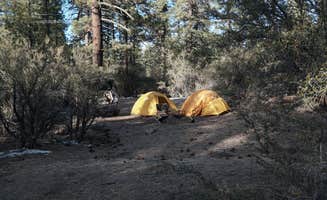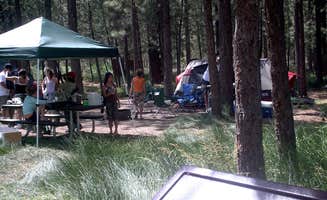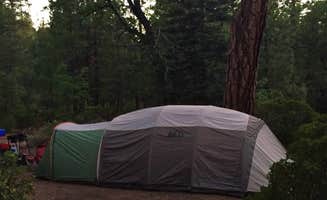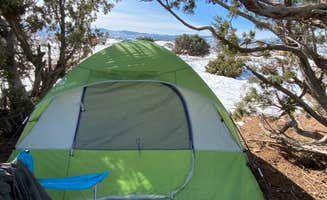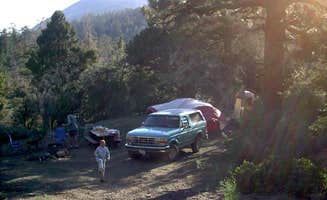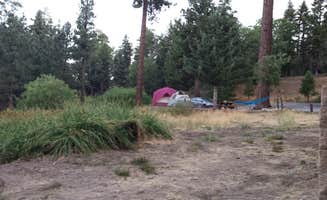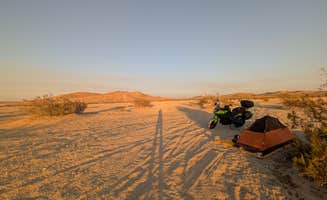Tent camping near Lucerne Valley, California offers diverse terrain from high desert at 3,000 feet to alpine forests exceeding 7,000 feet in elevation. The area experiences dramatic temperature variations with summer highs regularly reaching 100°F in lower elevations while mountain sites can drop below freezing at night even during summer months. Winter access to dispersed camping locations frequently requires snow chains or 4WD vehicles from November through March.
What to do
Rock climbing access: Holcomb Valley Climbers Camp serves as a strategic base for bouldering and sport climbing. "It is a free campground, first come first serve. There are no developed facilities (i.e., no firepits, outhouses, etc.) but it is beautiful and there are plenty of flat places to set up a tent. This area is used almost exclusively by rock climbers, but anyone is welcomed," notes Les R.
Hiking year-round: Thomas Hunting Grounds Yellow Post Campites connects to numerous hiking trails with varying difficulty levels. "We loved this yellow post site, by far one of my favorites. Private but with cell service, tables and fire pits! Listen to great horned owls while taking in the views!" according to Chelsea R.
OHV riding: From South Soggy Dry Lake, riders can access extensive off-highway vehicle networks. "Soggy has a long and very rocky road getting into the lakebed area. There are many camping spots all along the shoreline that will accommodate any size rig. From there you can reach all that Johnson Valley has to offer," reports Mike M.
What campers like
Privacy between sites: At Keller Peak Yellow Post Campsites, campers enjoy substantial separation between camping areas. "I really dig these spots because they are well spaced out. It's right around the corner from my cabin so it's a great spot to get outside for the weekend without an epic drive," shares Lynn C.
Elevation for summer cooling: Tanglewood Group Campground sits above 7,000 feet, providing relief during hot months. "Campground is nestled in pine woods where you have to drive quite far in through dirt road to get there. Pretty secluded, but accommodate our large group. Its location is in high elevation over seven thousand feet and pine woods were dense," explains Mon M.
No-cost tent camping: Mill Creek Dispersed Camping offers completely free camping on public land. "First come first served dispersed camping just outside Big Bear. Near bike trails. Was not crowded mid week, but spots were filling up closer to the weekend. There are a lot of flat spots to choose from," states Eileen S.
What you should know
Road conditions vary drastically: The approach to many camping areas requires preparation and appropriate vehicles. "The road up to the camp area is a bit rough. We were in a Sprinter and definitely nervous for parts. But, it was worth it once we got there!" shares Allie N. about Holcomb Valley Climbers Camp.
Water availability limited: Most sites near Lucerne Valley require bringing your own water supply. "This is yellow post camping so it's hit or miss if you can get one. Do your homework and learn what you need to know ahead of time - esp regarding fires," Kate W. advises about Keller Peak.
Fire restrictions change seasonally: Fire regulations vary throughout the year and by location. "They are very strict on parties are not allowed. NO FIRES. They have had issues with drug use and parties so thats why they are strict," warns David V. about Keller Peak Yellow Post Campsites.
Tips for camping with families
Consider accessibility needs: Mill Creek Dispersed Camping offers more manageable terrain for families with young children. "There are over a dozen sites along the main road. If you can pull in, it's a site. Some better than others and spaced out so you may not see your neighbors from your site. 2x4 accessible as long as it's not muddy or after snow. I saw a Prius on the trail," notes Dee M.
Regional parks provide more facilities: Yucaipa Regional Park offers structured camping with amenities for kids. "This is your typical regional park Campground. There's a lot to do here, including fishing, playgrounds, and even a waterpark in the summer. The bathrooms are decent, no showers," explains Mary F.
Weather preparation essential: Temperature swings can be extreme at high-elevation sites. "We went in April, and still had a little bit of snow. All the trail roads are mostly for 4 x 4 vehicles that really enjoy just going at it throughout the day," reports Seth B. about camping in the area.
Tips from RVers
Road assessment critical: Deep Creek Hot Springs Campground requires careful vehicle selection. "Rough ride in but totally worth it. The hike to the springs is pretty rough but also worth it when you get there. No hot showers," notes For Y.
Limited amenities mean preparation: Most dispersed camping in the area requires self-sufficiency. "My husband and I were looking for good boondocking spots yesterday and we decided to check out this spot. It's definitely a beautiful place, and most of the road to the site is paved, but the road up to the actual spot is gravel, with lots of potholes and washboard areas, which would make it difficult for an RV," Francisco F. cautions about Mill Creek.
Low-cost alternatives exist: Skoolies and converted vehicles can find accommodations at some sites. "We're usually full-time boondockers, and this was the first time we've paid for an RV park, so we don't have a lot to compare it to. But overall it's been a pleasant stay. Lots of shade, a pond, and reasonable rates. Most private RV spots discriminate against Skoolies, but this place didn't seem to care," shares Jason O. about Yucaipa Regional Park.


